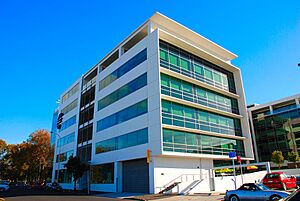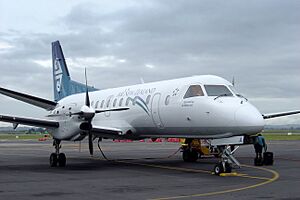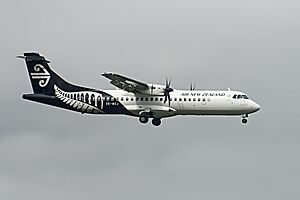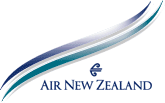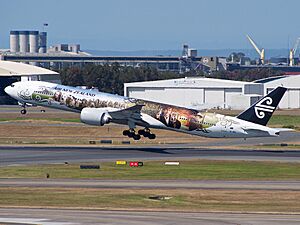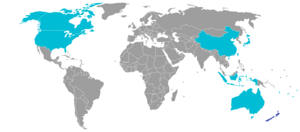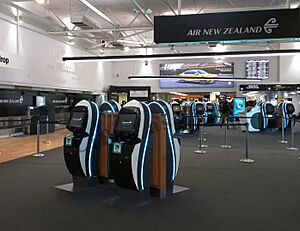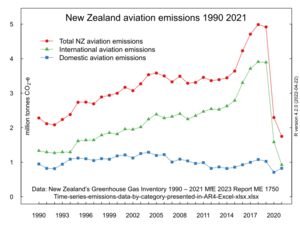Air New Zealand facts for kids
An Air New Zealand Boeing 787-9
|
|
| Founded | 26 April 1940 (as Tasman Empire Airways Limited) |
|---|---|
| Commenced operations | 1 April 1965 (as Air New Zealand) |
| Hubs | |
| Frequent-flyer program | Airpoints |
| Alliance | Star Alliance |
| Fleet size | 114 |
| Destinations | 48 |
| Headquarters | Wynyard Quarter, Auckland, New Zealand |
| Key people |
|
| Revenue | |
| Operating income | |
| Profit | |
| Total assets | |
| Total equity | |
| Employees | 8,863 (2022) |
Air New Zealand (which is Araraurangi Aotearoa in Māori) is the main airline of New Zealand. It is based in Auckland. The airline flies to 20 places within New Zealand and 28 places in 18 other countries. Most of its flights are around the Pacific Rim. Air New Zealand has been part of the Star Alliance group of airlines since 1999.
Air New Zealand started on April 1, 1965. It took over from an older airline called Tasman Empire Airways Limited (TEAL). At first, it only flew international routes. But in 1978, the government combined it with the domestic airline, New Zealand National Airways Corporation (NAC). This created one big airline under the Air New Zealand name.
The airline became a private company in 1989. However, the government had to take back most of its ownership in 2001. This happened because the airline was almost bankrupt after a difficult partnership with an Australian airline called Ansett Australia. In the year ending June 2017, Air New Zealand carried nearly 16 million passengers.
Air New Zealand's flights mainly connect to Australia and the South Pacific. It also has long-distance flights to East Asia and North America. It used to be the last airline to fly all the way around the world. These flights went to London Heathrow by way of Los Angeles and Hong Kong. The Hong Kong stop ended in March 2013. All flights to London Heathrow stopped in 2020. This was due to a lot of competition and not enough people wanting to fly that route.
The airline's main base is Auckland Airport. This airport is located near Māngere in Auckland. Air New Zealand's main office, called "The Hub," is about 20 kilometers from the airport. It is in Auckland's Wynyard Quarter.
Air New Zealand uses different types of planes. These include the Airbus A320, Airbus A320neo family, Boeing 777, and Boeing 787 jet planes. For shorter regional flights, it uses ATR 72 and Bombardier Q300 propeller planes. Air New Zealand won "Airline of the Year" awards in 2010, 2012, and 2023. In 2014, it was named the safest airline in the world.
Contents
Air New Zealand's Journey Through Time
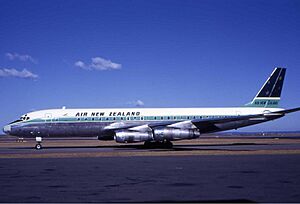
On April 1, 1965, Tasman Empire Airways Limited changed its name to Air New Zealand.
With new Douglas DC-8 jet planes, Air New Zealand started flying across the Pacific Ocean. In 1965, it added Los Angeles and Honolulu as destinations. The airline also bought larger McDonnell Douglas DC-10 planes in 1973. These DC-10s introduced the new koru-inspired logo. This logo is still used by the airline today.
In 1978, the domestic airline National Airways Corporation (NAC) joined with Air New Zealand. This created one national airline. As a result, NAC's Boeing 737 and Fokker F27 planes became part of Air New Zealand's fleet.
A sad event happened in 1979. Air New Zealand Flight 901 crashed. This affected the airline's reputation. The New Zealand Government and Air New Zealand formally apologized for this disaster in 2019.

In 1981, Air New Zealand started using its first Boeing 747 plane. A year later, it began flights to London through Los Angeles. The five 747-200 planes owned by Air New Zealand were all named after old Māori canoes. In 1985, Boeing 767-200ER planes were added. These planes filled the size gap between the smaller Boeing 737 and the larger 747.
In 1989, the airline became a private company. This was part of new economic changes by the government. Air New Zealand bought a 50% share in Ansett Australia in 1995.
In March 1999, Air New Zealand joined the Star Alliance.
Challenges and Changes
In 2000, Air New Zealand decided to buy all of Ansett Australia. This was an attempt to grow in the Australian airline market. However, this turned out to be a difficult decision. Ansett was much larger than Air New Zealand. Both airlines started to lose money.
In September 2001, the Air New Zealand / Ansett Group was close to failing. Air New Zealand had to put Ansett Australia into a special management process. Ansett then stopped flying. Air New Zealand announced a huge financial loss. The New Zealand Government had to help Air New Zealand. The government took an 82% share in the company. This saved Air New Zealand from possibly stopping all flights.
Air New Zealand in the 21st Century

In October 2001, the New Zealand government took back most ownership of Air New Zealand. This was part of a rescue plan.
In 2002, Air New Zealand changed its domestic flights to be more like a low-cost airline. The airline started making a profit again in 2003. In 2004, it improved its long-distance flights. New seats were added in business, premium economy, and economy classes.
In 2003, Air New Zealand added the Airbus A320 to its fleet for shorter international and domestic flights. In 2005, the airline received its first Boeing 777 plane. It also ordered the Boeing 787 Dreamliner in 2004. Air New Zealand was the first airline to use the larger 787-9 version.
On December 21, 2010, the New Zealand government approved a partnership between Air New Zealand and Australian airline Virgin Blue (now Virgin Australia). This allowed both airlines to work together on flights between Australia and New Zealand. Air New Zealand later bought a share in Virgin Australia. However, Air New Zealand sold its remaining share in Virgin Australia by October 2016. The partnership officially ended on October 28, 2018.
In 2011, Air New Zealand added the Boeing 777-300ER to its fleet. It also introduced the Economy Skycouch. This is a set of three economy seats that can turn into a flat surface for sleeping. After a four-year delay, Air New Zealand received its first Boeing 787-9 on July 9, 2014.
The airline stopped using its last Boeing 747 in September 2014. Its last Boeing 737 was retired in September 2015. The last Boeing 767 left the fleet in March 2017. This left Air New Zealand with a simpler fleet. It now uses Airbus A320 planes for short flights and Boeing 777 and 787 planes for long flights.
In November 2013, the New Zealand Government reduced its share in Air New Zealand from 73% to 53%.
In October 2019, the airline announced it would stop its Los Angeles to London route. Instead, it planned a new direct flight from Auckland to New York. In March 2020, Air New Zealand sold its flight slots at London Heathrow. The London route was stopped early in March 2020 due to the COVID-19 pandemic. The new New York route started on September 17, 2022.
Air New Zealand announced a big update to its plane cabins in June 2022. New cabins, including a product called "The Skynest," were introduced on new Boeing 787-9 and 787-10 planes. These planes were delivered in 2024.
In November 2024, Air New Zealand said it was looking into flying to London again. After not getting slots at Heathrow, the airline was given daily slots at London Gatwick Airport for summer 2025.
Air New Zealand's Business and Look
Main Office
The Air New Zealand main office, "The Hub," is a large office park in Wynyard Quarter, Auckland. It has two connected buildings with six levels each. The building uses a lot of glass to let in sunlight. This helps save electricity. The office does not have cubicle walls. Sensors turn lights on when people are there and off when no one is detected for 15 minutes. The buildings cost $60 million New Zealand dollars to build. The airline moved 1,000 employees into this new office in 2006.
The company also has offices at Smales Farm Business Park in Takapuna. This is where some of the customer service staff work.
Other Companies in the Group
Air New Zealand Cargo is the only current company owned by Air New Zealand Limited.
Air New Zealand used to own smaller regional airlines. These were Air Nelson, Mount Cook Airline, and Eagle Airways. They flew to regional places across New Zealand. Together, they were called Air New Zealand Link. Eagle Airways stopped flying in 2016. Air Nelson and Mount Cook Airline stopped in late 2019. Their operations were then taken over by Air New Zealand itself.
- Air Nelson was based in Nelson. It flew Bombardier Q300s.
- Mount Cook Airline was based in Christchurch. It flew ATR 72–500 and ATR 72–600 propeller planes.
Sponsorships
Air New Zealand used to be the main sponsor of the Air New Zealand Cup rugby competition until 2009. The airline still sponsors New Zealand rugby, including the New Zealand national rugby union team, known as the All Blacks. The airline also sponsors the Air New Zealand Wine Awards and World of Wearable Arts. It works with New Zealand's Department of Conservation and Antarctica New Zealand.
Brand and Look
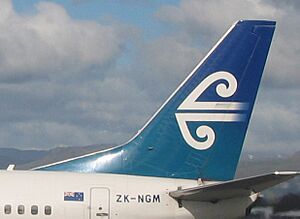
The Air New Zealand symbol is a Māori koru. This is a special design that looks like an unfolding silver fern leaf. A new logo was shown on March 21, 2006. The "Pacific Wave" stripes on the plane's body were removed from short-haul planes in 2009. This made the planes look simpler.
On March 27, 2006, Air New Zealand showed off a new look. This included new uniforms, a new logo, and new colors. The new uniforms used colors like greenstone, teal, and slate. These colors were inspired by New Zealand's sea and sky. The greenstone color replaced the blue Pacific Wave color. The Air New Zealand Koru symbol was used on all of the airline's signs and products.
A new rebranding was announced in July 2012. The airline stopped using the teal and green colors. Black became the main brand color. The tails of the planes and the airline's name changed to black. The rest of the plane stayed white.
The CEO at the time, Rob Fyfe, said that black felt right for the airline. He said it is the color of New Zealand and a symbol of Kiwi success. The airline started using black as its company color before sponsoring the All Blacks rugby team in 2011.
Another new look was announced on June 12, 2013. Air New Zealand was allowed to use the "New Zealand Fern Mark" on its planes. This is a standard fern logo used to promote New Zealand around the world.
Two new looks for the planes were shown. Most of the planes are white with a black stripe on the back. This stripe has a white koru logo. The black and white fern mark is on the side of the plane. Some planes have an all-black look with a silver fern. This includes the airline's first Boeing 787–9.
In November 2024, Air New Zealand leased a Boeing 777-367ER plane. This plane is all white with a black koru logo, which is different from the usual white koru.
Special Plane Designs
- In 1973, some planes had the "NZ74" logo for the 1974 British Commonwealth Games.
- In 1984, new Boeing 747-200Bs had "London, Here We Come" with pictures of horse guards.
- A special design with All Blacks rugby players was used on a Boeing 747–400 in 1999. This plane took the team to the Rugby World Cup.
- In 1999, one Boeing 737–300 had a 'New Millennium' design.
- In 2002 and 2003, Air New Zealand decorated three planes with The Lord of the Rings pictures. This showed it was "the official airline to Middle Earth."
- In 2008, one Boeing 737-300 was painted bright green with an Air New Zealand 'Holidays' design.
- In 2011 and 2012, two planes were painted with an All Blacks-inspired design. These planes were completely black with a silver fern.
- In November 2012, a Boeing 777-300ER was painted with a huge picture to promote The Hobbit movies.
- In December 2013, for the second Hobbit movie, Air New Zealand put two 54-meter-long pictures of the dragon Smaug on a Boeing 777-300ER.
Where Air New Zealand Flies
Air New Zealand flies to 20 places within New Zealand. It also flies to 30 international places in eighteen countries. These countries are in Asia, North America, and Oceania.
Air New Zealand used to fly some special routes. For example, it flew weekly from Rarotonga to Sydney and Los Angeles. In 2012, it started flying twice a week from Sydney and Brisbane to Norfolk Island.
Airline Partnerships
Air New Zealand works with other airlines through "codeshare agreements." This means they can sell tickets on each other's flights. Here are some of the airlines Air New Zealand partners with:
- Aerolíneas Argentinas
- Air Canada
- Air China
- Air India
- Air Tahiti Nui
- Aircalin
- All Nippon Airways
- Asiana Airlines
- Cathay Pacific
- Etihad Airways
- EVA Air
- Fiji Airways
- Korean Air (starting April 2025)
- Lufthansa
- Qantas
- Singapore Airlines
- South African Airways
- Turkish Airlines
- United Airlines
- Virgin Atlantic
- Virgin Australia
Air New Zealand's Planes
As of July 2025, Air New Zealand has 114 planes. The jet planes include: 17 domestic Airbus A320s, 5 domestic Airbus A321neos, and 9 Airbus A321neo and 6 A320neo planes for international short flights. For long flights, it has ten Boeing 777-300ER and fourteen Boeing 787–9 Dreamliner jet planes. The airline has two Airbus A321neo, one ATR 72, two Boeing 787-9 and six Boeing 787-10 planes on order.
The airline's propeller planes fly regional domestic routes. There are 53 of these planes: 30 ATR 72–600 planes and 23 De Havilland Canada Dash 8 Q300 planes.
Services for Passengers
Plane Cabins
Air New Zealand offers three types of seating on its large Boeing 777 and 787 jets: business class, premium economy, and economy class. On its smaller Airbus A320/A321 jets and propeller planes, it has a single economy class cabin.
In-flight Wi-Fi
Since October 2017, the airline has been slowly adding free in-flight Wi-Fi service to its planes. In February 2024, the airline announced that it would offer free Wi-Fi using Starlink satellite Internet on all its routes. This service was fully available in 2025.
Air New Zealand Lounge
The Air New Zealand Lounge is a network of special waiting areas at airports around the world. Members of Air New Zealand's frequent flyer program, like Koru members, can use these lounges.
Airpoints Program
Airpoints is Air New Zealand's program for frequent flyers. Members earn "Airpoints Dollars." These can be used like real New Zealand dollars to pay for any Air New Zealand flight. Members can also reach different status levels, like Silver, Gold, and Gold Elite. These levels give them more benefits. Airpoints Gold and Gold Elite members get the same benefits as Star Alliance Gold members across the Star Alliance network.
Safety and Environmental Efforts
Incidents and Accidents
As of November 2022, Air New Zealand has had four major plane losses and two hijackings. The airline's most serious accident, and the only one with passenger deaths, was Flight 901. This happened on November 28, 1979. The plane crashed into Mount Erebus during a sightseeing flight over Antarctica. All 257 people on board died.
Reducing Emissions
In 2008, Air New Zealand and Boeing looked into using the jatropha plant to make aviation biofuel. A two-hour test flight used a mix of this new biofuel and regular jet fuel. The engine worked well, showing no problems. Jatropha was seen as a possible future fuel.
In 2022, Air New Zealand set a goal to reduce its emissions by almost 29% by 2030. In July 2024, Air New Zealand announced it would no longer pursue its 2030 climate target. It also left the Science Based Targets initiative (SBTi).
Awards and Recognition
In 2020, Air New Zealand was named "Best Airline" by AirlineRatings.com.
In 2023, Air New Zealand was named AirlineRatings.com's Airline of the Year.
Baggage Tracking
Air New Zealand and Star Alliance partner Lufthansa briefly stopped allowing baggage trackers in 2022. However, these bans were reversed in 2023.
See also
 In Spanish: Air New Zealand para niños
In Spanish: Air New Zealand para niños
- Air transport in New Zealand
- List of airports in New Zealand
- List of airlines of New Zealand
- Transport in New Zealand


